 | |
| Formation | 1994 |
|---|---|
| Dissolved | 1998 |
| Purpose | Artscene |
| Location | |
Fire, later known as Fire Graphics, was an underground computer artscene group that released ANSI, ASCII, and high resolution artwork from 1994 to 1998.
 | |
| Formation | 1994 |
|---|---|
| Dissolved | 1998 |
| Purpose | Artscene |
| Location | |
Fire, later known as Fire Graphics, was an underground computer artscene group that released ANSI, ASCII, and high resolution artwork from 1994 to 1998.

Fire was founded in July 1994 by ANSI artists Donut Hole and Vendetta as a parody of iCE, one of the top art groups of the time. From the second pack onward, the group was ostensibly led by Halaster, who gradually elevated Fire by recruiting talented artists from regional art groups, and by becoming a competent ANSI artist himself. After releasing monthly collections of their work, Fire planned a merger with Canadian artscene group Mistigris, in March 1995. The merger was unsuccessful and Fire collapsed shortly thereafter when Halaster quit the group to join ACiD.
In August 1995, Halaster quit ACiD and re-formed Fire. After its rebirth, Fire became a popular and critically successful group, releasing artwork and applications such as the DOS based ANSI editor, Pyrodraw. At various points in time, Fire was home to some of the most respected ANSI artists in the scene, including Iodine, Eerie and Prisoner #1.
Through most of its history, Fire was headquartered at The Regency BBS, located in Atlanta's 404 area code. The Regency was one of the few dial-up BBSs that transitioned to IP technology via use of the telnet protocol. This transition was short-lived and only marginally successful, but allowed Fire to retain its headquarters after most BBSs had closed. The Regency's geographic location contributed to the early history of the group, as most of its initial artistic roster hailed from Atlanta.
In February 1997, Halaster stepped down from his leadership position and chose hirez artist God Among Lice, coordinator of the hirez section since April 1996, and ANSI artist Eerie to assume his duties of group leader and coordinator of the ANSI section respectively. After just one pack Eerie unexpectedly left the group and German ANSI artist Nail took over coordination of the ANSI section in April 1997, subsequently recruiting more European artists into the group's ranks.
However, with the rising popularity of the Internet and dropping interest in ANSI art Fire found itself struggling to stay true to its roots with more and more of its ANSI artists quitting the medium altogether.
God Among Lice and Nail eventually decided to end the group after pack #33 rather than keep going and being forced to release packs that they deemed unfitting for Fire, which they ultimately still considered an ANSI art based group.
fire #33 - the final combustion was eventually released several months late in September 1998.
In 2021 Blocktronics released their 34th pack as Fire #34 with contributions by several former Fire members.
Fire had a separate ASCII sub-group called Fire ASCII, but unlike the relationship between ACiD Productions and Remorse ASCII the art was, with just a few exceptions, released in the Fire packs instead of separate ASCII packs.
Fire also maintained a separate music/tracking entity called Radiance.
Fire had a small crew of coders, headed up by Wintermute aka Winmutt and Maxwell. This group was responsible for creating Pyroview, which was among the first art-scene viewers to support JPEG images.
Another of the groups ground breaking creation was a raster based graphics protocol with embedded sound support that was supported in Dialtone! (a serial communications / terminal emulation program) and the System/75 BBS software written for the DOS operating systems. System/75 BBS was a full featured message board and file sharing center. Dialtone! was one of the first serial comm apps to integrate a war dialer with a fully fledged dial comm supporting all of the popular file transfer protocols of the day.

Fire released its members' artwork in monthly artpacks.

ASCII art is a graphic design technique that uses computers for presentation and consists of pictures pieced together from the 95 printable characters defined by the ASCII Standard from 1963 and ASCII compliant character sets with proprietary extended characters. The term is also loosely used to refer to text-based visual art in general. ASCII art can be created with any text editor, and is often used with free-form languages. Most examples of ASCII art require a fixed-width font such as Courier for presentation.

A bulletin board system (BBS), also called computer bulletin board service (CBBS), is a computer server running software that allows users to connect to the system using a terminal program. Once logged in, the user can perform functions such as uploading and downloading software and data, reading news and bulletins, and exchanging messages with other users through public message boards and sometimes via direct chatting. In the early 1980s, message networks such as FidoNet were developed to provide services such as NetMail, which is similar to internet-based email.
The computer art scene, or simply artscene, is the community interested and active in the creation of computer-based artwork.

.nfo is a filename extension for text files that accompany warez scene releases of pirated software or media.
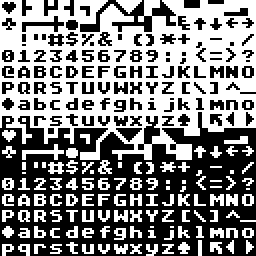
The ATASCII character set, from ATARI Standard Code for Information Interchange, alternatively ATARI ASCII, is the variation on ASCII used in the Atari 8-bit family of home computers. The first of this family are the Atari 400 and 800, released in 1979, and later models were released throughout the 1980s. The last computer to use the ATASCII character set is the Atari XEGS which was released in 1987 and discontinued in 1992. The Atari ST family of computers use the different Atari ST character set.
ACiD Productions (ACiD) is a digital art group. Founded in 1990, the group originally specialized in ANSI artwork for BBSes. More recently, they have extended their reach into other graphical media and computer software development. During the BBS-era, their biggest competitor was iCE Advertisements.
Christian Wirth, better known by the pseudonym RaD Man, is an American computer artist and historian. He works in the field of ANSI art, a method of creating art using a limited set of text characters and color escape codes based loosely on the relevant ANSI standard.
FILE_ID.DIZ is a plain-text file containing a brief description of the content of archive to which it belongs. Such files were originally used in archives distributed through bulletin board systems (BBSes) and is still used in the warez scene. FILE_ID stands for "file identification". DIZ stands for "description in zipfile".
ANSI art is a computer art form that was widely used at one time on bulletin board systems. It is similar to ASCII art, but constructed from a larger set of 256 letters, numbers, and symbols — all codes found in IBM code page 437, often referred to as extended ASCII and used in MS-DOS and Unix environments. ANSI art also contains special ANSI escape sequences that color text with the 16 foreground and 8 background colours offered by ANSI.SYS, an MS-DOS device driver loosely based upon the ANSI X3.64 standard for text terminals. Some ANSI artists take advantage of the cursor control sequences within ANSI X3.64 in order to create animations, commonly referred to as ANSImations. ANSI art and text files which incorporate ANSI codes carry the de facto.ANS file extension.
An artpack is an archive of computer artwork which is distributed in a compressed format such as ZIP or RAR.
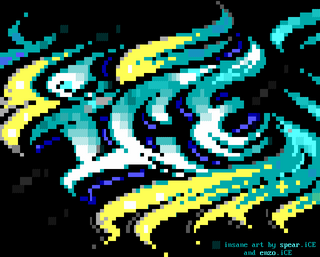
iCE Advertisements is a digital art group founded in Canada by Many Axe in 1991. Although the expanded title is rarely ever used, iCE is an acronym for Insane Creators Enterprise. iCE, along with ACiD Productions, was one of the most prominent and critically successful groups on the underground computer artscene.
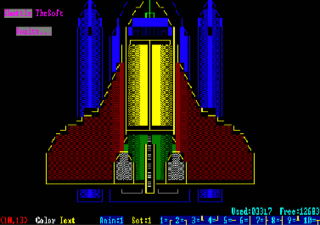
TheDraw is a text editor for MS-DOS to create ANSI and animations as well as ASCII art. The editor is especially useful to create or modify files in ANSI format and text documents, which use the graphical characters of the IBM ASCII code pages, because they are not supported by Microsoft Windows anymore. The first version of the editor was developed in 1986 by Ian E. Davis of TheSoft Programming Services. The last public version of the editor was version 4.63, which was released in October 1993.
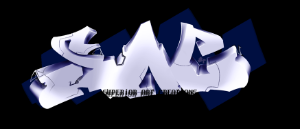
Superior Art Creations (SAC) is an underground artscene group which caters primarily to and is well known within the warez scene. SAC members have made, besides ANSI and ASCII art, VGA bitmap graphics, tracker music, and a variety of other works. SAC's character graphics have also been used in bottles and FTP servers.

Soulz at Zero (SAZ) was a lit group formed in 1994 by Jack Flack and The Stranger. SAZ released 25 monthly packs over a period of two years, beginning in September 1994 and ending in September 1996. The group took its name from a Souls at Zero poster Flack had in his bedroom at the time, with the trailing "s" in "Souls" changed to a "z". Soulz at Zero was so well known that their name was added to the "Elite Acronym List," which was used to separate "lamers" from "elite users."

Creators of Intense Art, or Cia was an underground computer artscene group that primarily released ANSI, ASCII, and high resolution artwork from 1993 to 2001. Along with iCE and ACiD, Cia was one of the most active, and longest lasting groups on the artscene.
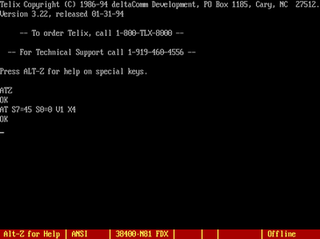
Telix is a telecommunications program originally written for DOS by Colin Sampaleanu and released in 1986. On October 10, 1988 in the release note for Telix 3.10, Sampaleanu announced the creation of 'Exis Inc.'; name used to develop the software until September 25, 1992; which is when Exis Inc. sold Telix to former Exis Technical Support Manager Jeff Woods, who founded 'deltaComm Development Inc.' and it was distributed by them thereafter, including the Microsoft Windows version they developed and released in 1994.
Blade, also referred to as The Blade Nation, was an underground computer artscene group that primarily released ANSI, ASCII, and high resolution artwork from 1994 to 1997, and during a brief time in 1998.
This is a list of the minor computer underground artscene groups spanning from roughly 1992 to the present day.
ASCII Express is a telecommunications program, written for the Apple II series of computers. At a time when the use of the bulletin board system (BBS), or even telecommunications in general wasn't a common use of the Apple II, ASCII Express was the choice among telecommunication users throughout much of the 1980s.
Aces of ANSI Art was the first group of artists specifically organized for the purposes of creating and distributing ANSI art. The group was founded and operated by two BBS enthusiasts from California, "Zyphril" and "Chips Ahoy", from 1989 through 1991.